Models are as hot as rocks!
In a recent paper in JGR-Solid Earth, EarthByter Ömer Faruk Bodur and colleagues show that mantle lithosphere rheology has a primary control on the subduction style (i.e., one-sided vs. double-sided subduction) and strongly affects the pressure-temperature conditions of metamorphic rocks that can be buried >100 km depth and exhume to the surface! This long journey … Read more…






















